This post is for you, Steve. So sorry you and Alane couldn't join us last Sunday. Get well soon, buddy!
 |
Get well soon!
Violet-pink sand verbenas with a few white dune evening primroses, brown-eyed primroses, and popcorn
flowers are hidden in this natural bouquet. Borrego Springs, California. March 12, 2017. Greg Gillson.
|
"Super bloom." That's what they're calling it on the news. "Super traffic jam" as 5000 thousand cars tried to enter the tiny village of Borrego Springs each day this past weekend with only two roads into town from San Diego. The highways converge at a giant traffic circle/city park in the center of town--called Christmas Circle.
Why the "super bloom"? Rainfall amounts in the populated western half of the county are about double the annual average. Trouble is, there have been 5 years of way-below-average rainfall creating the local drought, mirrored by drought for the entire state of California. Emergency drought water restrictions appear to be ready to be lifted. San Diego has stored water enough for 3 years, now, if the reports are to be believed. The persistent rainstorms we put up with this winter, and the flooding and sandbags and vigils I put in at our mobile home park, brought water to the desert east of the mountains, too. The desert received more rainfall than in 12, 20, or 30 years, depending upon who you ask. We seemed to hit the peak of flowers this past weekend. Next weekend will be good still, and then quickly fade.
Borrego Springs is in the middle of the northern section of the Anza-Borrego Desert. It's only 45 miles away, but up and over the mountains--away from the moderating influence of the ocean--it takes an hour-and-a-half to drive there. And an extra 2 hours to get home this past weekend, as we averaged 10 mph for 20 miles between Borrego Springs and the Warner Springs intersection--usually empty road except for a few RV's. Guess what? The line of last-minute flower seekers and art show participants was just as long still trying to get into town at 2:30 pm when we were leaving after a full day! Marlene and I couldn't believe it, Steve, but people parked on the side of the highway and walked to town starting more than 3 miles outside of town--and it was well into the upper 90's! I'm so glad we arrived at dawn and missed driving into the sunrise on those curvy roads descending into the desert!
 |
| Miles outside of town as we were leaving was still clogged with people trying to get in.... |
Here's why bird watchers like the wildflowers, Steve. Yes, they do look pretty. But I think I'm not that different from most other birders when it comes to flowers. Trees and biomes are important for determining what birds live where. So I know the identification of most of the trees and major plant communities in North America. Flowers? Not so much. Flowers in the Anza-Borrego Desert are good for one thing birdwise--food for
caterpillars of the sphinx moth. The caterpillars feed on the flowers and get big and fat--big as your thumb big and fat. Migrant Swainson's Hawks--primarily insectivores--on their way from their winter home in Argentina to their breeding grounds in the great American West, eat these juicy morsels on the morning of their one overnight migration stop here. The first birds arrive about the first of March and some are still moving through until mid April. This week is all about the bloom; the next few weeks will be about the caterpillars. Thus, the hundred or so hawks that were in town overnight had few or no caterpillars to keep them on the ground in the morning. I saw three flocks of about 55 total birds lift off about 10 am, catching a thermal, and circle high into the sky.
Official counters tallied 209 birds that lifted off and continued on their northward migration.
I was hoping to show you and Alane around the Desert, Steve. The mountains, the flowers, the hawks, the other birds, the cacti, and the metal sculptures. Sorry you were ill. We visit 3-4 times in winter and spring--it's one of our favorite getaways. This time Marlene and I concentrated on the wildflowers and also birds at the Roadrunner Club. Since you couldn't make it, I present you with this trip report. Join us another time, won't you?
 |
| Scenic S-22, Montezuma Valley Road, overlooking the Anza-Borrego Desert at sunrise. This road descends steeply with continuous sharp curves for a dozen mile from Ranchita to Borrego Springs. I like it because RV's and large trucks usually don't take this road. On the horizon you can sea the Salton Sea, 35 miles to the east of Borrego Springs. |
We started Daylight Savings time this day, so sunrise was an hour later, and we had an extra hour to sleep in before we had to get up, even though we lost an hour of sleep during the night. Now
there's a confusing thought! The goal was to enter town at or before sunrise at 7:00 am, as the road we were on looked straight into the sunrise. Perfect timing. By the way, it was 42F at Ranchita before we descended the grade into Borrego Springs. It was 72F near the foot of the mountains. But only a mile or two through town it was back to 57F. But within an hour after sunrise it was pushing 80F, peaking about 95F in the early afternoon. Arriving early beats the heat!
A call to the
Wildflower Hotline told us where most of the bloom was taking place. And the most recent email from the
Borrego Valley Hawkwatch indicated a hundred hawks had arrived the previous evening and that based on weather forecast we could expect to see them nearby in the air between 9 and 10 in the morning. At 7:30 am we drove around the roads circling the area where the hawks went to roost the night before. We didn't see any hawks perched in trees or feeding in the fields. It was early yet for the hawks, so we headed over to Old Springs Road open space preserve--sand dunes where Le Conte's Thrashers are resident. This is the only location in San Diego County you can find these birds. Plus I had seen flowers in these dunes in the past. It did not disappoint.
 |
| Wildflowers at Old Springs Road, Borrego Springs, California. March 12, 2017. Greg Gillson. |
Thank goodness the Anza-Borrego Desert State Park has a foldout brochure called "Spring Wildflowers of Anza-Borrego Desert State Park" to help me identify most of the flowers I photographed!
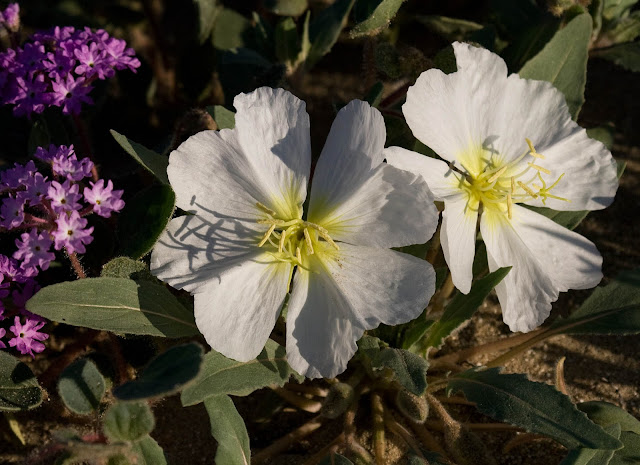 |
| Dune evening primrose |
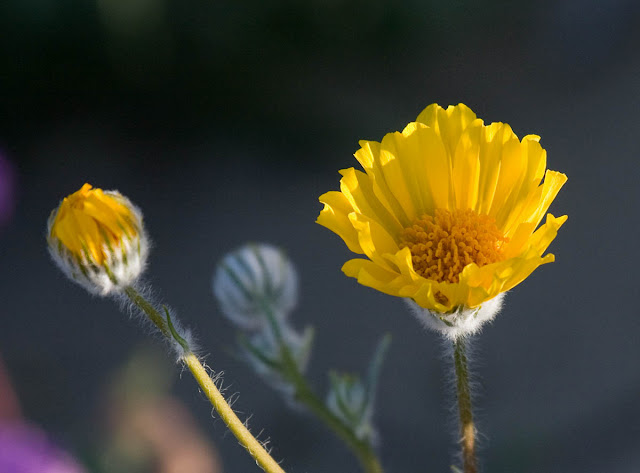 |
| Desert sunflower |
 |
| Brown-eyed primrose |
 |
| Desert lily |
 |
| Popcorn flower |
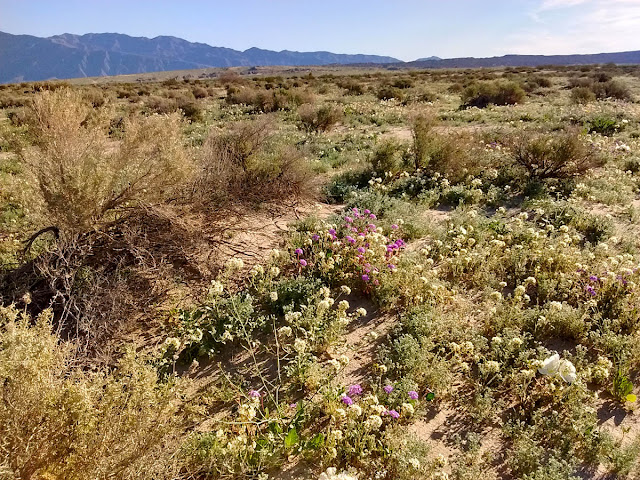 |
| Desert wildflowers |
 |
| Desert dandelion |
 |
| Desert sunflower |
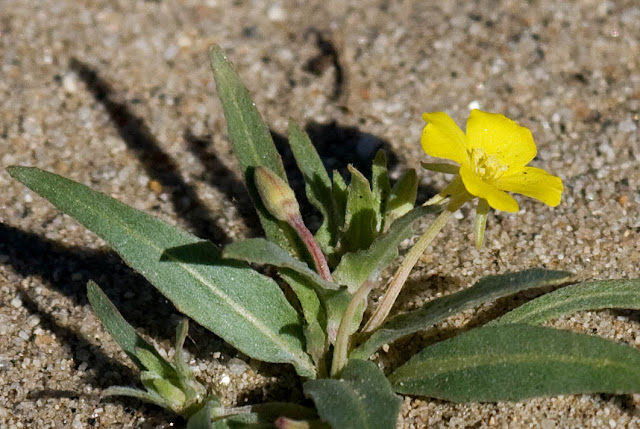 |
| Unidentified flower, Anza-Borrego Desert State Park. |
 |
| Sand verbena |
 |
| Desert lily |
 |
| Leaves of desert lily drawing circles in the sand. |
 |
| Little gold poppy |
 |
| Brown-eyed primrose |
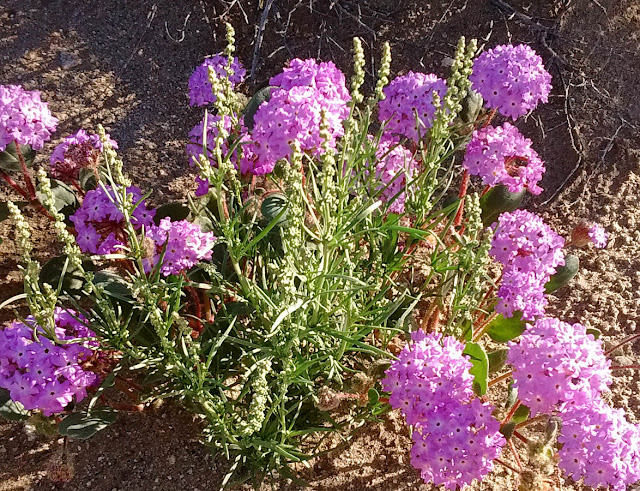 |
| Sand verbena |
We then drove out past Henderson Road, which was this weekend's advertised flower site. The sweet smell of desert sunflowers was quite strong. The first wave of flower gawkers lined the roads and spread out across the yellowed sands.
 |
| Desert sunflowers on Henderson Road |
After this we went over to the waste treatment ponds, which attracts birds to the water and desert shrubs there. It is actually not as disgusting as it sounds. Unfortunately a group was target practicing nearby and the ricocheting bullets buzzing overhead was enough to make me decide to go elsewhere.
At this point I drove over to one of the hawkwatch sites. A dozen birders were there looking in all directions for any hawks flying. One person gave me a suggestion of where I might see hawks roosting. So I went there to walk a road. No luck trying to get a close photo. Later, a mile away or more, I saw three groups of 55 hawks circling into the sky ready to catch a thermal to take them on their next leg of their very long migration. Official counters tallied over 200 hawks leaving the Valley on this morning. But no caterpillars meant no birds out feeding in the flower fields.
 |
| A small kettle of 10 Swainson's Hawks circling up into a thermal. |
The rest of the day's bird photos I'll save for a separate post.
At this point we headed to breakfast at Kendall's Café. We made it in at 11:00 am as the last breakfast customers before they switched to the lunch menu.
There are hundreds of metal sculptures out in the desert. We decided not to visit this day. But we found several (copycats?) in the "mall." Here's a sample.
We decided to visit the fields off Borrego Springs Road. We noticed how green it was when we passed earlier. This area is plots of land for sale to be developed. During most of the year it is dry, and the few cacti and other plants there look like dead bleached sticks. Ocotillos only put out leaves immediately after rains. And as soon as the ground dries out the leaves fall off. The red flowers bloom in spring, with or without (usually) the leaves. We found some additional species of flowers we hadn't photographed earlier.
 |
| Flowers carpet the sands among the Gander's cholla, ocotillo, and creosote bushes. |
 |
| The ocotillo's dark green leaves only last a week or two. |
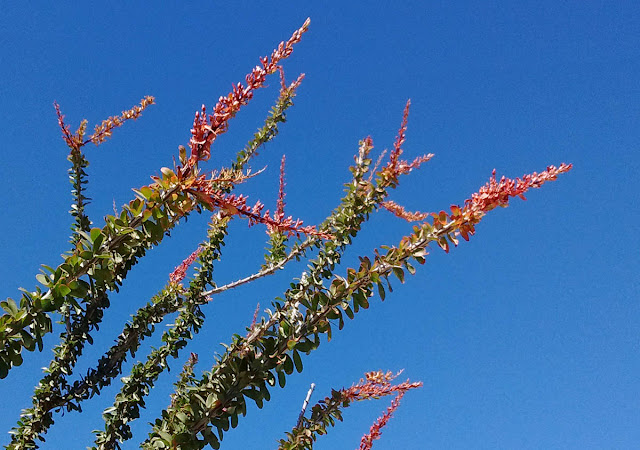 |
| Soon, all the tips of the ocotillo will bloom |
 |
| Some of the leaves of the ocotillo turn red |
 |
| Desert chicory |
 |
| Purple mat |
That's the end of our wildflower adventure. From here we decided to drive through the Roadrunner Country Club to look for birds, since our earlier birdwatching was disrupted. So that will be my next post...





























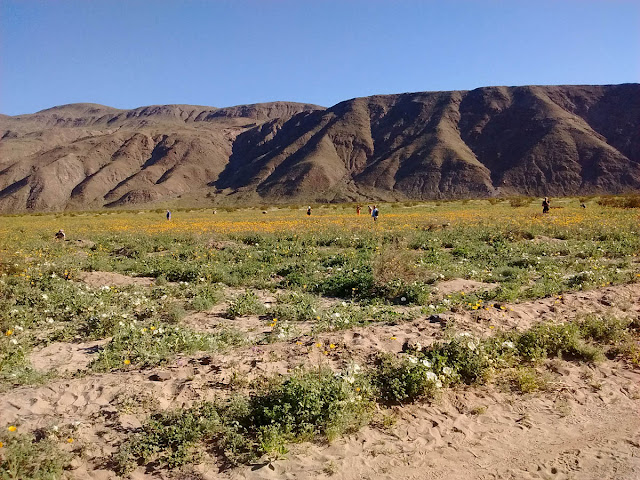

No comments:
Post a Comment
I really want to hear from you! I've changed settings (again) in order to try to make commenting easier without opening it up to spammers. Please note, however, that comments to posts older than 14 days will be moderated. Thank you.